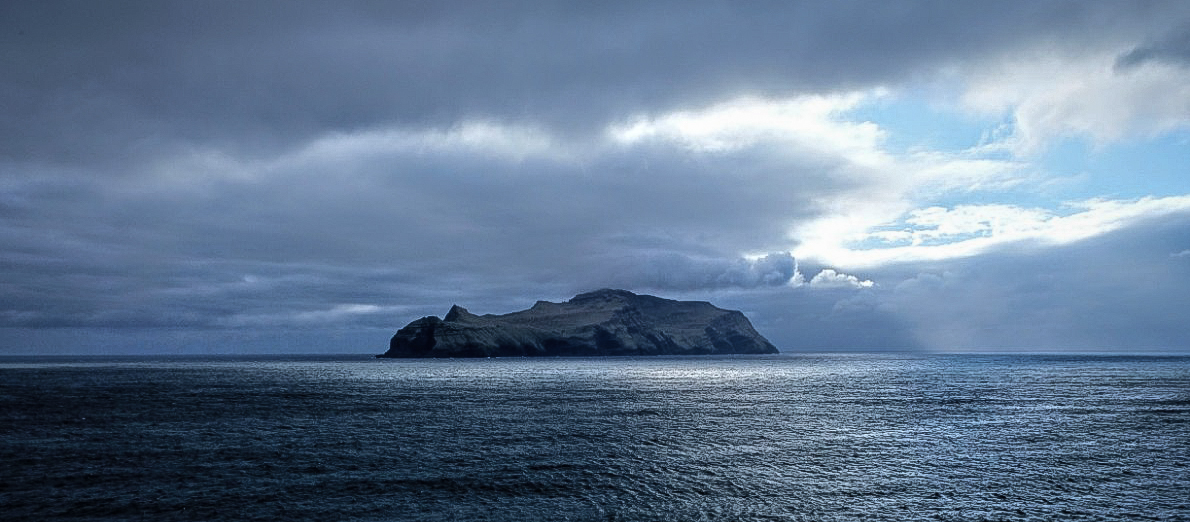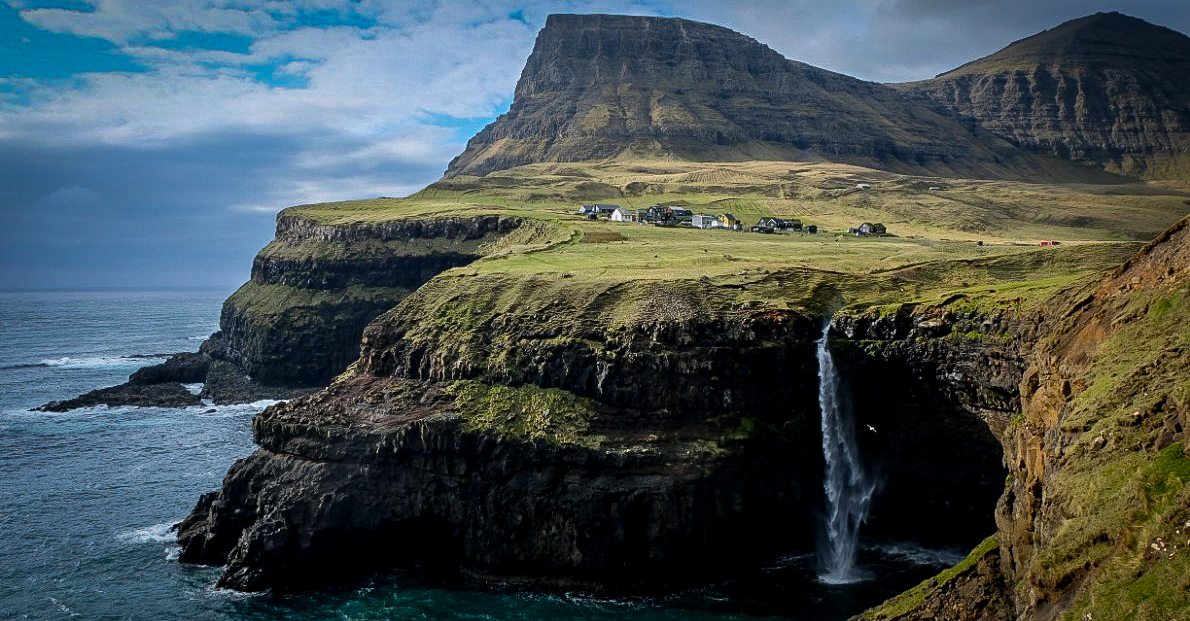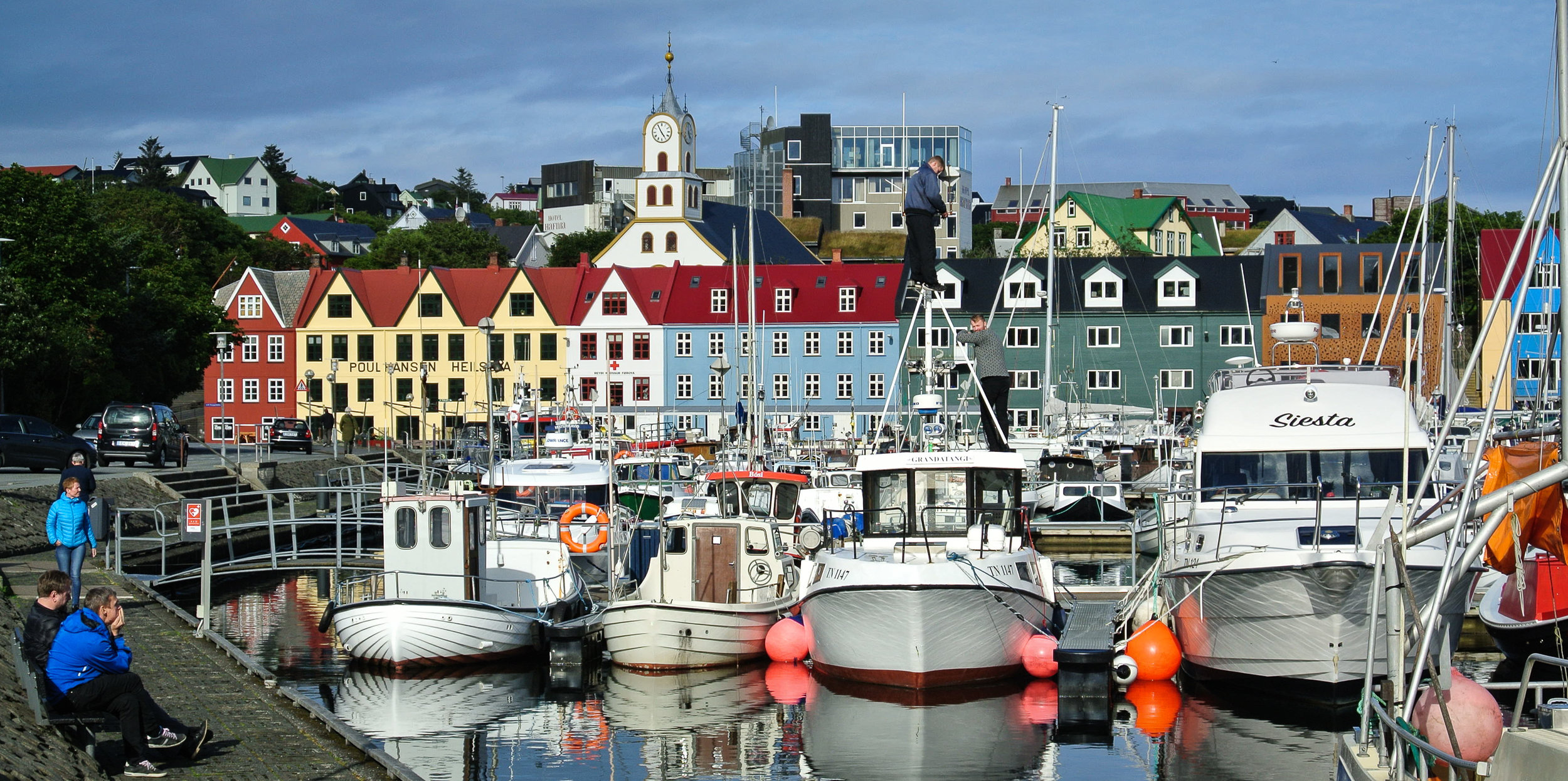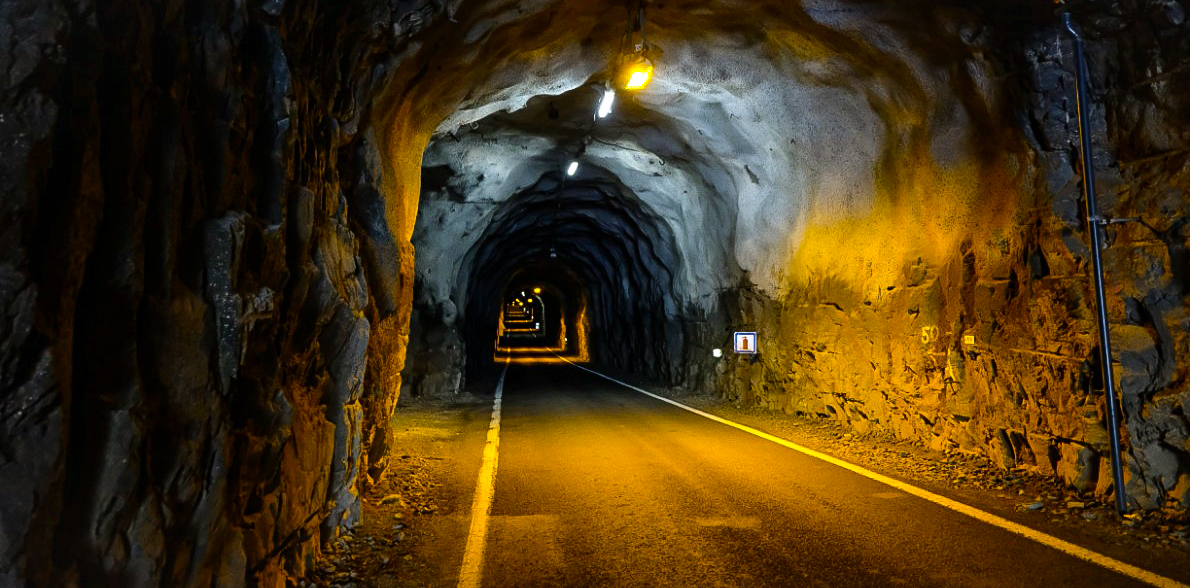The Small Faroese Nation That Always Thinks Big
COMMUNITY / INFRASTRUCTURE
Writer: Mia Bennett, Cryopolitics
Photographs: Mia Bennett, Vilborg Einarsdottir
June 2018
Fifty-five million years ago, the North Atlantic Ocean opened up between Europe and Greenland, pushing the two landmasses apart. In the middle of this incipient churning ocean, massive volcanic eruptions spewed volcanic ash and bombs and layer upon layer of dark gray lava basalt flows. Over millennia, the basalt grew six kilometers thick, forming the geologic base of the Faroe Islands. Mia Bennet looks at how the Faroese blasted through these rocks in what often is referred to as the “the tunnel craze”, a 40 year period which not only opened up shorter routes and better connections, but - and maybe more importantly - opened the minds of Faroese people to a bold vision of future opportunities and a path towards the prosperity they now enjoy. And the small Faroese nation continues to think big when it come to infrastructure.
Today, only 900 meters of the ancient volcanic rock rises above the water. Ripping winds and heaving seas have slowly carved the hardened lava into 18 precipitous spits of land. For one and a half millennia, from the first period of settlement by Gaelic and Norse peoples between 400-600 AD until 1973, the only way to travel between the small villages hugging the archipelago’s shorelines was by boat. Then, a bridge opened between the two most populous islands: Streymoy, where the capital of Tórshavn is located, and Eysturoy. People no longer needed to wait for the car ferry to go back and forth. Suddenly, a half-day journey took only a few minutes. The bridge was a precursor to an even more momentous occasion that took place thirty years later, when the country's first subsea tunnel opened. It connects Streymoy to Vagar, the island where the international airport is located. Another subsea tunnel opened in 2006, and two more are currently under construction.
Driving around the Faroe Islands today, car commercial-ready roads descend into neon-lit subsea tunnels that spit you back out into a world of grassy islands connected by ephemeral misty rainbows. The country's hardy fishermen and sailors have taken the plunge, replacing once treacherous journeys by sea with effortless drives beneath the waves.
A brief history of underwater tunnels
Underwater tunnels may seem fantastical and futuristic, but they have existed since 1843. That year, tourists from around the world came to see the first such tunnel in London, beneath the Thames River. An American traveler, William Allen Drew, called the attraction the "eighth wonder of the world." It was designed for use by horse-drawn carriages, but financial problems prevented the construction of the necessary ramps. Only pedestrians traversed the tunnel for over twenty years, when the first trains started running through it.
In the 150 years since, more underwater tunnels have opened in and between the world's wealthiest cities, from Hong Kong's Cross Harbour Tunnel to the Chunnel between England and France. Port cities like San Francisco and New York City build subsea tunnels to allow subways and vehicles to speed underwater while ships can continue to sail overhead without the potential obstructions caused by bridges. As the world continues to speed up, submarine travel facilitates the ceaseless movement of people, goods, and capital.
In their fuelling of constant connectivity, underwater tunnels seem like sensible infrastructure to build in the world's non-stop metropolises. The association between tunnels and speed is one reason, however, why the emergence of a dense network of subsea and onshore tunnels in the remote Faroe Islands, situated between Scotland, Iceland, and Norway, seems so unlikely.
"Part of the fantastic development that you see in the Faroes over the past 50, 60, 70 years is very much related to the ambition of building this infrastructure, as an entity on its own, and initiated by its own citizens. Because if we were relying on initiatives coming from outside, like Denmark, we would still be a very underdeveloped society. There's no doubt about that.".
The Faroe Islands: Life in the slow lane
A shepherd tending to his flock in the Faroe Islands in the year 2018. JONAA©Mia Bennett
Life moves slowly on these grassy volcanic outcroppings, where the language has not evolved dramatically from Old Norse. In 825, an Irish monk named Dicuil wrote of the Faroes, "Countless sheep and many different species of sea-fowl are to be found there." Twelve hundred years later, the description still holds.
The Faroese are even more traditional than their Icelandic cousins. Men tend to be the main breadwinners and women stay at home to raise the children. While Reykjavík twenty-somethings spend weekends clubbing or Laugavegur Street or shopping in New York City, many Faroese still go out to sea every morning except on Christmas - the only day the government prohibits commercial fishing. One farmer I met in the village of Gásadalur - population 18 - who was originally from Iceland remarked that he told his son that living in the Faroes is like living in "La La Land." No one really demands much of you, and life moves unhurriedly. Cradling his shy three-year old daughter, the farmer added that he never watched the news, for instance, and if war erupted, he would find out by gazing at the sea. (He'd also named all his daughters after Greek gods, and his sons after Norse ones.)
So why do these islands where the rhythm of the ocean still determines the ebb and flow of daily life have more tunnels per capita than any country on earth? The answer might lie somewhere in local residents' desire to enhance their connections to each other even as - or perhaps because - the archipelago remains fairly remote from the rest of the world.
A map of bridges and subsea tunnels in the Faroes. Map by ©Cryopolitics.
The bridge and tunnel crowd arrives
Before the Faroese built subsea tunnels, they slashed passages through their mountains. North of the Faroes' second largest city, Klaksvík - population 4,740 - two single-lane tunnels cut through the basalt rock, leading to the villages of Árnafjørður and Depil. Landsverk, a public institution established in 1948 under the Ministry of Transport, Infrastructure and Labour, built these tunnels, the islands' first, in the 1960s. Frighteningly narrow and unlit, they have well-marked pull-outs every 10 meters or so to allow oncoming traffic to pass.
While driving through these shadowy corridors is not for the faint of heart, it is far easier than trudging over the mountain, which was the previous option. Over coffee at the Arctic Circle Forum held in the Faroese capital of Tórshavn earlier this month, Magni Arge, a pro-independence Member of Parliament for the Faroe Islands and former CEO of the national airline, Atlantic Airways, animatedly recalled what happened once these tunnels were built: "Suddenly, you open up in your mindset that there are other options than only building roads, or walking or sailing."
Magni Arge, MP for the Faroe Islands from the Tjóðveldi Party in the Danish Parliament and former CEO of Atlantic Airways. JONAA©Mia Bennett
And so the Faroese tunnel craze was under way. Between 1963 and 2006, Landsverk blasted 17 shortcuts across the islands, helping to cement more and more of the population together. They achieved this with some help from the Norwegians, perhaps the world's most legendary tunnel builders. Engineers from the oil-rich country have drilled passages through 25 kilometer-thick granite fjord walls and are even considering an underwater tunnel for ships.
Working at a more modest scale in the Faroes, the last tunnel the government's team constructed was a 1,400-meter tunnel to the tiny village of Gásadalur. That's the tiny town at the literal end of the road in the Faroes, where the isolationist farmer lives with his sheep, chickens, wife, and mythologically-named children. Prior to 2006, residents (and the mailman, who made the journey three times a week) had to walk three kilometers over a steep and windswept mountain to shop for groceries or pick up supplies. Even burying the village's dead required carrying coffins up and down the precarious slopes. Given the town's tiny population, Arge called this tunnel "a bit of a crazy one." Yet he noted, "It opened up Gásadalur for all of us."
The picturesque village is home to the most photographed sight in the Faroes: a waterfall plunging wildly off a cliff into the ocean. The winds ripping off the crashing waves are so fierce that sometimes the waterfall sprays up into the air like an out-of-control lawn sprinkler. Tourists often head straight for this spot after landing since Gásadalur is just 12 kilometers from the airport. While most reach the town by rental car, I set off in my running shoes under rare blue skies.
The first ten kilometers of the journey were filled with views of sheep grazing in every grassy nook and cranny, skeletal, ashy islands borne of a volcanic furnace, and a quaint town called Bøur, whose name simply means "field." Just a little ways after entering the tunnel, I felt like I had stepped into an enormous noise-canceling device that abruptly silenced the howling gusts and bleating sheep outside. (The three Highland cows near the entrance had happily filled their mouths with hay, so they were already mute.) The tunnel’s only sounds were slowly dripping water, humming lights, an occasionally rumbling car. After running for about 10 minutes, the white circle of light at the end of the tunnel grew bigger until the road thrust me into the valley of Gásadalur. The skies on this side were misty and grey, but they had been crisp and clear on the other side of the weather wormhole.
Going underground and undersea
After gaining experience building tunnels on land, the Faroese began looking to the ocean. In the 1980s, the Norwegians started building their own underwater chasms, inspiring the Faroese. They wanted to replace their aging car ferries, which were expensive to purchase and maintain, with subsea tunnels. These submarine cement wonders would provide other advantages as well. Uni Danielsen, managing director of Vága-og Norðoyatunnilin, which operates the first two subsea tunnels which were built, explained, "The advantage of having a tunnel is that it's open 24 hours a day, there's no waiting for the ferry, there's more mobility - it's getting more dynamic."
In 2000, a parliamentary act approved the construction of the country's first subsea tunnel, which would link Vagar, the island where the main airport is located, to the Faroese "mainland." The Norwegian division of Swedish construction company NCC and two Faroese companies were contracted to build the five-kilometer tunnel. It took workers a little over two years to build the tunnel using the conventional drill and blast method, with crews digging away from each side until they met in the middle.
Vága-og Norðoyatunnilin - an independent, limited liability company fully owned by the Faroese government - was established to own and operate the Vaga tunnel. Like so much in the Faroes, the model behind private tunnel operation draws on lessons from the fishing industry. Bergfrost, a frozen fish storage company, blasted the country's first privately owned tunnels into the side of a mountain near the fishing port of Fuglafjorður in the 1990s. Their capacity has grown from 7,000 to 25,000 tons in two decades, which has allowed them to keep pace with the ongoing North Atlantic fishing boom and store hauls of mackerel and whiting brought in by fleets from Greenland, Iceland, Ireland, Scotland, and Russia.
Trucking in the Faroes. JONAA©Mia Bennett
The Vaga tunnel required more complicated engineering works than onshore frozen fish tunnels, but it was still surprisingly cheap and efficient to build. The government provided DKK 160 million (US$20.3 million) in financing, while local banks provided the remaining DKK 140 million (US$17.8 million), with the tunnel and roads used as their guarantee.
"Many people thought that we were crazy when we started to build it, but it showed to be an extremely successful project," Arge recalled. The tunnel provided a link between the airport and the rest of the island, which was particularly important for the export-oriented fishing industry. "The tunnel is one leg to the global world," Danielsen described.
Sound financial management and the unexpected popularity of the tunnels, with traffic growing 134% over the same amount of time, helped pay off the loan two years early. The Faroes' second subsea tunnel, which opened in 2006 between Vagoy and Klaksvík, has met with similar success. Remarkably, the toll for the Vaga tunnel has decreased by 76% since its opening in 2003. Ultimately, the Vaga tunnel was supposed to be free for the Faroese drive, but maintenance costs have so far impeded that. "It's more expensive to maintain subsea tunnels than other tunnels," Danielsen stated. "They have leaks, you have to pump out the water." Anywhere from 600 to 1,300 cubic meters of water a day are evacuated from each of the Faroes' subsea tunnels. Most of the water comes not from the ocean, but surprisingly from groundwater that leaks into the parts of the tunnel running through dry land.
The continuation of tolls hasn't deterred the Faroese from driving around the archipelago. With newfound wealth from the ongoing fishing boom, many residents have imported Mercedes-Benz cars to cruise around on the islands' world-class roads. Camper vans are also a common sight in the front yards of many Faroese homes. This might seem odd in such a small country, but one morning as I was carpooling with Limberg Michelsen, a software developer from Sørvágur, the town near the airport, into Tórshavn, he explained that that they are useful for taking the family along and setting up camp at the many festivals that take place across the archipelago in summer. They're also good for making a few extra Danish krone: for my first night in the Faroes, I stayed in his camper van, which he rents out as an AirBNB.
Michelsen added that had the Vaga tunnel not been built, he and his family probably would have long ago moved to Tórshavn. Instead, the tunnel allows them to stay in their coastal town with a view of islands straight out of a medieval fantasy novel while he commutes into the capital most days of the week. Vagar's population has actually been growing significantly in recent years. The country's steadily increasing connectivity does not seem to be something the Faroese necessarily take for granted, but rather something of which they take advantage.
Today, the Faroe Islands' 18 onshore and two subsea tunnels run for a total of 44 kilometers through mountains and under fjords. Journeys across the archipelago that used to take an entire day have been reduced to an hour, and 87% of the population is now connected 24/7.
The first roundabout under the Atlantic
Now, it seems, the sky – or perhaps the seafloor – is the limit. In 2014, the Faroese Parliament unanimously decided to build an additional two subsea tunnels from the main island of Streymoy. One will shorten the drive to the island to Eysturoy, an island to the north, while the other will connect to Sandoy, an island to the south currently only accessible by car ferry. The website of the publicly-held limited company responsible for the project, Eystur- og Sandoyartunlar, calls it "the biggest infrastructure expansion on the Faroe Islands ever." It will require DKK 400 million (US$62.5 million) from 2014-2024. The Eysturoy tunnel will even have what CEO Teitur Samuelsen thinks is "the only roundabout under the Atlantic Ocean" (American drivers, beware).
Construction is not cheap: a study by Samuelsen and a Norwegian professor, Eivind Grøv, finds that these two new subsea tunnels will cost over €50,000 per inhabitant, whereas other similar projects in Europe cost far less than €10,000 per person. Despite the expense, all of the country's political parties support the decision to keep expanding the country's infrastructure network. They recognize the benefits provided by the tunnels, which will also directly benefit the economically vital and politically powerful fishing industry, which generates 95% of the country's exports.
Samuelsen noted, "The main export route of the Faroe Islands is from Tórshavn, and the main production of the fishing industry and farming and salmon is in the north region, so it will make the business environment more efficient."
A map of the Estyuroy tunnel slated in 2020. Map by ©Cryopolitics.
The Faroese have become so used to a well-oiled transportation network that they protest when a ferry is out of commission for too long. When I was in town, the schedule for the boat to Nólsoy, the island right offshore from Tórshavn, had been reduced due to maintenance on one of the ferries. Danielsen told me on a blustery Friday afternoon, "There will be a demonstration down in the harbor at two o'clock. They'll give you coffee if you go." Apparently, the Faroese like their social movements civilized and caffeinated.
Another tunnel megaproject in the works
Once the two tunnels under construction open - or perhaps even before - the Faroese government will likely set its sights on what might possibly be its final subsea project: an ambitious, 24-kilometer tunnel to connect the mainland to the southernmost island, Suðuroy. This project would connect all of the country's main islands and leave only a handful of sparsely populated ones, like puffin-filled Mykines (population 14), detached from the road network.
Samuelsen believes that even though a tunnel to Suðuroy would be far more expensive than any project yet undertaken in the Faroes, it would still financially viable. Whereas the cost of a new tunnel would be $3 billion DKK, replacing the existing car ferry would cost $800 million DKK. The tunnel CEO stated, "The operation of the ferry per year is maybe half a kilometer of tunnel. So if you look at the investment over maybe 30 or 40 year perspective, then it should be possible." When tunnel-kilometers become your yardstick for measuring all sorts of infrastructure, you know you've become a tunneling nation. Ultimately, if the Suðuroy tunnel is built, the Faroese tunnel network would equal two meters of tunnel per inhabitant, according to his estimate.
The Suðuroy tunnel would bring other benefits, too. "It's a huge improvement of the infrastructure for those living there," Samuelsen said. About 4,600 people - a little less than ten percent of the country – resides on the island, but its population has been dwindling since the 1950s. A tunnel might help stem that outflow. It would also open up what is some the country's best agricultural land and allow more recreational opportunities. Finding extra real estate is important in such a small country, especially when the locals like to jump from place to place in their camper vans.
Building strength in remoteness
On the road in the Faroe Islands. JONAA©Mia Bennett
Some countries export their infrastructure know-how once they become experts. Norway has sold its tunneling skills overseas, while Japan and China do the same with their high-speed rail technology. The Faroe Islands, however, have yet to do so, even though some workers have followed the Norwegians across the water to assist on projects there.
For now, the Faroese may be content to keep working on building their own infrastructure. Arge, the politician and entrepreneur who supports independence from Copenhagen, remarked, "Part of the fantastic development that you see in the Faroes over the past 50, 60, 70 years is very much related to the ambition of building this infrastructure, as an entity on its own, and initiated by its own citizens. Because if we were relying on initiatives coming from outside, like Denmark, we would still be a very underdeveloped society. There's no doubt about that."
Danielsen, the managing director for Vága-og Norðoyatunnilin, similarly maintained that remoteness and "neyð", a Faroese word that roughly translates to misery and wretchedness, has helped the country learn to stand on its own two feet. Looking out the window of his sunlit office, the banker-turned-tunnel-manager recalled a Faroese saying: "Suffering helps a woman to knit and get warm. Otherwise, she will freeze." Like Arge, he insisted on the importance of self-help rather than assistance from Denmark or anyone else. "It's very important that it comes from the Faroese themselves," he asserted. In building their subsea tunnels, the Faroese have returned to the sea - this time, in warm sweaters they have knit themselves. ▢
Mia Bennett is an assistant professor in the Department of Geography and School of Modern Languages & Cultures (China Studies Programme) at the University of Hong Kong and editor of the Cryopolitics blog. Through fieldwork and remote sensing, she researches the politics of infrastructure development in frontier spaces, namely the Arctic and areas included within China's Belt and Road Initiative. This article is republished as a part of media collaboration between Cryopolitics and JONAA.













